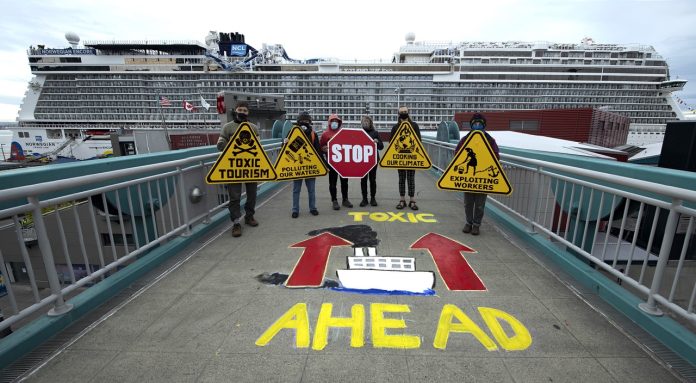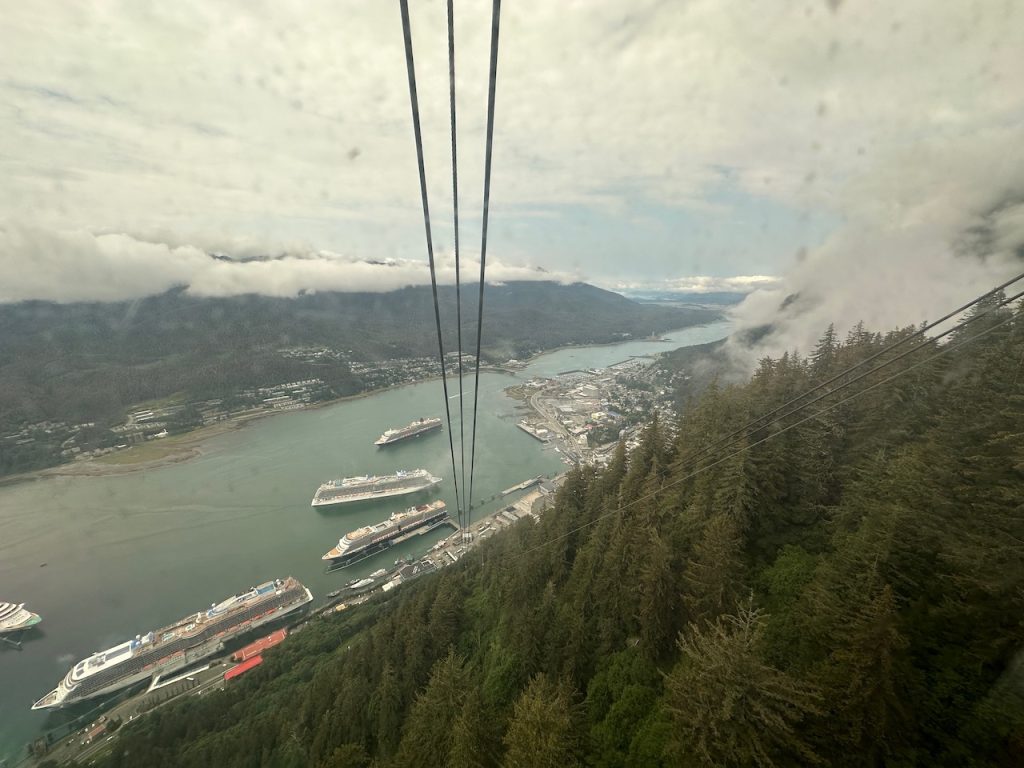
Opening day of another Alaska cruise season offers no cause for celebration to anyone who loves the Pacific Northwest and wants to see our communities healthy, thriving, and economically sustainable. Regional decision makers need to look beyond the glossy ads and public relations hype to ask how, in a little over two decades, we have allowed the Port of Seattle to impose on us a form of tourism whose very business model is based on wrecking the climate, polluting the air and water, exploiting labor, and putting all that we love at risk.
As the first cruise ship of the season boards on Saturday, April 6, Seattle Cruise Control, joined by Climate Action Families, Washington Physicians for Social Responsibility, Water Warriors, and International Coalition for Human Rights in the Philippines, will stage a family-friendly rally at Pier 66. The event is endorsed by two dozen additional youth, climate, Indigenous, health, social justice, and marine protection organizations, including Friends of the Earth, Center for Biological Diversity, Global Cruise Activist Network, and 350 Seattle.
Beneath the looming backdrop of the Norwegian Bliss – 20 stories tall, carrying 6,000 passengers and crew – the 11am rally will feature a press conference led by kids dressed as sea creatures. These young people have been thinking a lot about the future they will inherit, and we’ve invited Port Commissioners and local elected officials to listen to their concerns.
The cruise industry’s climate impact is staggering: greenhouse gas emissions from a single season of Seattle-based Alaska cruises and accompanying air travel account for one-third as much climate pollution as the entire city of Seattle produces in a year. Cruise ships dump four billion gallons of toxic waste annually into our waters. This includes sewage and greywater, but most of it is “scrubber waste” — instead of satisfying emissions limits by burning more expensive low-sulfur fuel, cruise ships buy the cheapest, dirtiest fuel there is, and use emissions cheat systems to “scrub” poisonous sulfur out of the smokestacks and dump it into the ocean. When not plugged into shore power, a single cruise ship emits the smog of 34,000 diesel trucks. The ships’ engine noise disrupts feeding and communication of threatened marine mammals, making it harder for starving orcas to find food.
Cruise also takes a significant toll on workers and communities. Onboard workers are paid as little as $2 an hour and are required to work 12-hour shifts with no days off for months at a time. And destination communities in Alaska increasingly find themselves overwhelmed: seasonal worker housing drives up local rents, while tourist crowds crash the internet, clog roads, impede emergency vehicles.
You’ll never see an Alaska mega cruise ship registered in the U.S. – flags of convenience allow these billion-dollar corporations to skirt U.S. labor and environmental protections. And dodge taxes. This week’s tragic Francis Scott Key Bridge collapse in Baltimore reveals the extent to which foreign-flagged megaships not in compliance with US labor and safety regulations put us all in harm’s way.
The cruise ships towering over Seattle’s new waterfront bring in revenue and thousands of jobs – but so would prison construction, or an oil refinery. We have to compare the benefit of these seasonal jobs to the harms the business itself inflicts on us all. Cruise ships’ smokestack emissions pollute the air we breathe, increasing rates of sickness and premature death among shoreline communities.
Pollution, ocean acidification, and warmer water all harm the seafood industry; climate disruption devastates the farms that grow our food and the outdoor recreation economy our rural areas rely on; deadly heat and smoke events cause suffering for all, with particularly acute health risks to children and elders. This is the dilemma government and Port officials need to confront, but they consistently ignore or disregard these negative impacts and their costs.
The Port of Seattle constantly proclaims itself “the greenest port in North America,” but don’t be fooled by this greenwashing, or by that of the cruise industry. The port’s so-called “Green Cruise Corridor” remains hazy and largely aspirational: it’s merely an agreement to explore the possibility of zero-emissions ships. Participation in the corridor is voluntary, with no binding goals, deadlines, or enforcement mechanisms.
Shore power, which allows ships to plug into Seattle’s clean electricity while at berth, won’t be mandatory for another six years; in 2023, only 35% of ships used it. Even when ships do plug in, it’s for no more than seven hours, out of a journey that lasts at least seven days. And most Alaska ports lack the electrical capacity to support shore power at all: residents there are subject to air pollution the entire time the ships are in town.

Cruise companies advertise their cruises as “green” because they run on LNG (liquefied natural gas), but due to leakage and its greater warming effect, LNG is actually more harmful to the climate than conventional marine fuels. Meanwhile, with global heating already catastrophic for humanity and on course to get much worse, cruise companies plan to expand their business by almost 20% between 2022 and 2028.
What can residents of Seattle and King County do? Speak truth to the Port: our families and communities should no longer be forced to bear the externalized costs of toxic tourism. The Port’s 25-year history of “incremental change” has failed to address the massive health, environmental, and social consequences central to the cruise business. Cruise lines will not eliminate water, air, and climate pollution on their own; the only way for the Port of Seattle to achieve the substantial and ongoing reductions necessary is by reducing the number of sailings we host.
Here are some additional policies the Port could implement immediately: Until zero-emissions cruise is a reality, require cruise corporations to spend the money to buy the cleanest low-sulfur fuel available, eliminating the scrubbers that turn air pollution into water pollution. Require all berthed cruise ships to use shore power: this cannot be a voluntary decision left to the operators. Monitor cruise’s environmental and health impacts by restoring the onboard observer program canceled by the state of Alaska a few years ago, and expand it to cover the entire route. These common-sense approaches are all feasible; if the Port of Seattle truly worked for the well-being of our region, they would demand the cruise industry comply.
We’re all stakeholders here. And we’re called upon to meet our own needs without ruining the prospects of our children and grandchildren. Across the globe, from Cozumel to Bar Harbor to Barcelona, cities and residents are recognizing there’s nothing green about cruise tourism.
The Port should be encouraging new, sustainable lines of business for our region, not promoting, celebrating and greenwashing one of the world’s worst. Come join us on April 6th!


